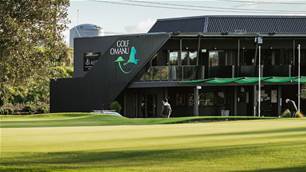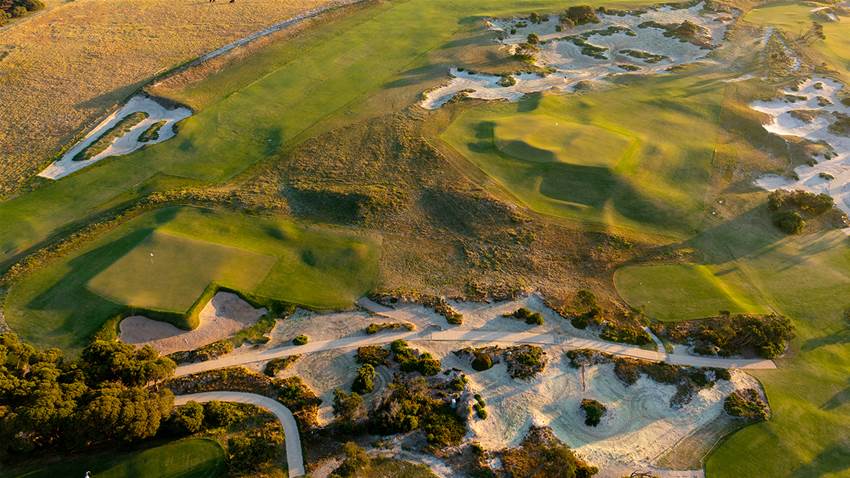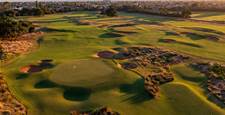For so long the golf courses of Victoria’s Bellarine Peninsula have existed in the shadow cast by the amazing layouts of the Mornington Peninsula, which is just a 40-minute ferry ride across Port Phillip Bay.
Geelong lies at the western end of the Peninsula and is home to several public accessible courses, with the best of them being the nine-hole Geelong Golf Club.
Located about 10 minutes’ drive north of the city centre, Geelong has twice been ranked among the best nine-holers in the country by Golf Australia magazine.
Geelong wasn’t always a nine-hole course and boasts a history stretching back to 1892. But after more than a century as an 18-hole layout, the club was forced to close in 2004. In the decade that followed, land was sold off for development and the course reopened as nine holes in 2014.
Course architect Graham Papworth created the design which flows nicely across quality golfing terrain and features beautifully presented Santa Ana couch fairways and tees as well as some excellent bentgrass putting surfaces.

It’s not an overly long course but it definitely tests your approach shot skills course as Papworth’s green complexes don’t lack for contours and are often surrounded by cavernous bunkers, mounds and swales.
With three teeing options on each hole, the course is enjoyable for players of all standards. Even low single figure players will discover there is a real challenge to find the best spots to attack the flags as leaving yourself on the wrong side of the hole, or even on the wrong tier, can ensure the best score you will make is a bogey.
Geelong features some terrific short par-4s but, for mine, the best of them is the tree-lined 282-metre 3rd. The first of five bunkers – that lie diagonally from left-to-right across the fairway – is easily reached with a shot of about 215 metres. The closer you get to the green, the easier the second shot becomes but the slightly uphill drive must be straight to avoid the sand left and rough to the right.

The seaside resort town of Torquay, about 21km from Geelong, is probably best known for its surfing roots. Here you will find the world-famous Bells Beach, but there is some good, fun golf to be found as well.
The original course at Torquay was designed by the father and son team, Mick and Vern Morcom, who gained fame for their long greenkeeping careers at Royal Melbourne and Kingston Heath respectively.
In the mid-2000s, the RACV purchased the course and commissioned OCCM (Ogilvy, Clayton, Cocking and Mead) to rebuild the layout over a three-year period while an adjoining resort and day spa was constructed.
The new links-style RACV Torquay course opened for play in 2012 and features generally firm conditions and the ever-present wind, which goes hand-in-hand with its coastal location. The bunkering is relatively small and simple but in many cases the surrounds are contoured to feed balls into the sand. The greens feature subtle slopes and are receptive to running shots, especially those played from the correct side of the fairway.
By comparison, RACV Torquay’s nearest golfing neighbor The Sands Torquay, less than 10 minutes’ drive away, features far more expansive sandy hazards.
The name really says it all ... The Sands, Torquay. The developers of this fine golf course didn’t miss the mark when they bestowed the name upon this layout.
As the name suggests this course features plenty of sand – in fact there are more than 100 bunkers scattered across the landscape between the 1st tee and the 18th green. And this is marginally less than what was in the ground when the Stuart Appleby-designed layout opened for play in 2004.

There is little doubt Appleby’s design team – which included veteran course designer Brit Stenson from International Management Group Design – was influenced by the bunker work of Dr Alister MacKenzie and his associate Alex Russell in the Melbourne Sandbelt during the 1920s. Appleby, for one, has described the bunkering in the Sandbelt as the best in the world so it should come as no surprise that his first foray into course design would see him try and emulate the best.
The designers did a pretty good job in creating some wonderful bunkering schemes that not only intimidate players visually but also deceive you on the distance remaining on some shots.
The front nine – set among a growing residential development – offers fairways zigzagging between bunkers or wetlands or both. But it is the back nine that will really excite the first-time visitor to The Sands as more undulating topography, giving rise to a greater range of shots, comes into play.
From the championship markers, the 435-metre 11th is the longest and most brutal par-4 on the course. Despite being played downwind on most days, this two-shotter is played uphill past a small grouping of Moonah trees before the fairway splits into two as part of the natural slope and the ideal location for some bunkers. The approach is uphill to a green where only the top of the flag is visible. There is no tougher shot to be found on the course.

The best par-3 at The Sands is its shortest – the 148-metre 13th. The green is perched high above the tee on a ridge and you have to trust your club selection, as most of the green cannot be seen, despite sloping markedly from back to front.
The 400-metre par-14th is one of the most beautiful holes at The Sands. Laid out on land that was formerly part of the Torquay rubbish tip, there are seven bunkers ready to halt your progress along this fairway, which is set on the edge of a ridge and features a steep slope down off its right edge. The putting surface is also set carefully on a sideslope, with mis-hits right or long of the green finding inevitable trouble.
Visitors to The Sands in recent years might have noted the course was looking a little tired and the presentation had dropped off. But the course, and the adjoining resort, was put up for sale by receivers last year after the Chinese companies that owned and operated both were placed in the hands of administrators.
Former Morgan Stanley vice president Jack Dahan bought the course and resort for $12.8 million in March and future investment in the course will certainly see it push hard for a return to a Top-100 ranking spot.
WHERE TO STAY
SEAHAVEN VILLAGE
Seahaven Village is centrally located in Barwon Heads, just a stone’s throw away from shops, cafes and beaches.
The village has a wide range of premium self-contained accommodation options including 14 apartments, cottages and suites located on-site at 3 Geelong Road, Barwon Heads, just two minutes’ drive from Barwon Heads Golf Club. There are also four off-site apartments, townhouses, cottages and suites just around the corner from Seahaven Village.
For availability and costs, checkout the website www.seahavenvillage.com.au
PEPPERS THE SANDS TORQUAY
Peppers The Sands Torquay Resort, just an eight-minute walk from the beach, is a contemporary, premium golf resort where you can relax in beautifully designed studios and suites with a balcony or terrace affording stunning views over the course.
Other amenities include a refined restaurant, a bar, an indoor lap pool and tennis courts, plus a fitness room and meeting rooms.
For availability and costs, visit www.thesandstorquayresort.com

THE BARWON HEADS GOLF CLUB
Travellers have been making use of the accommodation facilities within the iconic Barwon Heads clubhouse since 1924.
There are 19 ensuite rooms available for members and their guests, for golfers wishing to stay before or after a round, and for those visiting Barwon Heads seeking a traditional, service-oriented experience.
For more details, visit the club’s website www.barwonheads.golf
WHERE TO PLAY
LONSDALE LINKS
Green fees: $80 (weekdays); $90 (weekends)

THE BARWON HEADS GC
Green fees: $120 (weekdays); $160 (weekends). $80 (weekday, house guest); $105 (weekends, house guest).
THIRTEENTH BEACH GOLF LINKS
Green fees: $95 (weekdays); $115 (weekends). $130 (weekday, 36 holes*); $160 (weekends, 36 holes*). *Check availability.

CURLEWIS GC
Green fees: $60 (weekdays); $70 (weekends).
PORTARLINGTON GC
Green fees: $55 (weekdays); $60 (weekends).
GEELONG GC
Green fees: $30 (18 holes), $20 (nine holes).
THE SANDS TORQUAY
Green fees: $50 (weekdays); $60 (weekends).
Related Articles

Review: Omaha Beach Golf Club

Drinks With... Ricky Ponting













